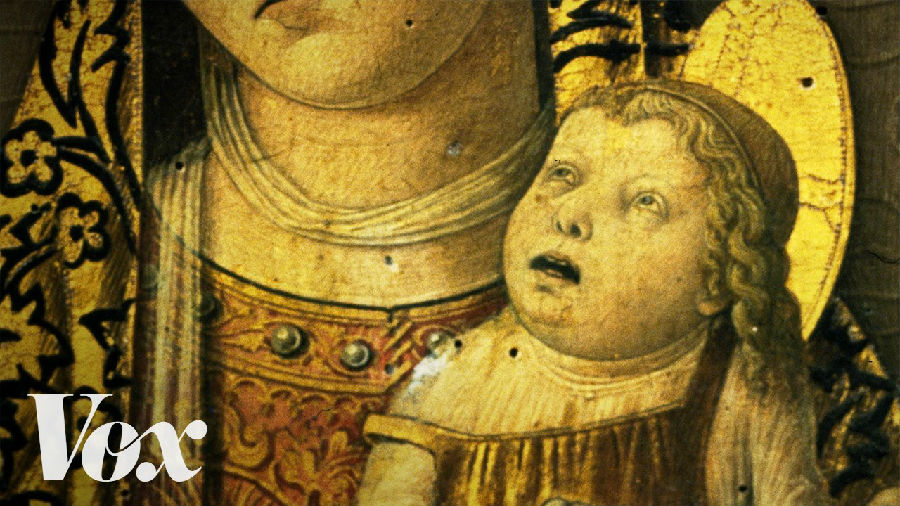(单词翻译:单击)
原味人文风情:
So, you're going to the museum, and it's great.
你去参观一座博物馆,而且它超赞的。
The guards check your bag to make sure you won't, I don't know, shoot a painting.
守卫检查你的包包以防你开枪射一幅画之类的。
You go up some fancy escalators, you see naked statues, and then it happens. You see a super ugly medieval baby.
你搭着美美的电扶梯往上,见到光溜溜的雕像,然后重点来了。你看到一个丑不拉叽的中世纪宝宝。
Why did medieval babies look like ugly middle-aged men?
为什么中世纪的宝宝看起来像丑丑的中年男人?
I mean this baby looks like he wants to tell you that a boat is just a money pit.
我是说这宝宝长得一副想告诉你‘养一艘船简直贵死宝宝’的脸啊。
It might seem like medieval artists were just bad at drawing, but it turns out that babies in medieval art are actually ugly for a reason.
这么看来似乎中世纪的画家不擅长绘画,但其实中世纪艺术里的宝宝长得丑是有原因的。
While there were breakthroughs in anatomy and perspective that happened later in the Renaissance,
尽管之后的文艺复兴时期在解剖学和透视法上有所突破,
ugly medieval babies were an intentional choice before that time.
但在那之前的中世纪宝宝们是故意被画丑的。
If somebody told you to paint like Pablo Picasso, and you gave them Norman Rockwell, you'd have screwed up.
如果有人要你画得像毕加索,结果你画给他们洛科威尔,你就完了。
And it was the same way for medieval artists working in churches in Italy. It's because most of these babies were depictions of Jesus and Mary.
而当时在意大利教堂工作的艺术家们也是这样。因为那时大多数的宝宝画像都是在描绘耶稣跟玛利亚。
They were influenced by the idea of the homunculus, which is Latin for "little man."
他们的外貌受到 homunculus 这个词的影响,在拉丁文这个字的意思是“小矮人”。
These babies looked like Benjamin Button because philosophers believed Jesus was born perfectly formed and unchanged.
这些宝宝看起来像班杰明·巴顿是因为哲学家相信耶稣生来就已经发育完全并且外貌永不改变。
The adult Jesus was represented in the baby Jesus until the Renaissance, when everything changed.
成人耶稣的外貌呈现在宝宝耶稣的脸上,一直到了文艺复兴时期,一切才有所改变。
Generally, we think of the Middle Ages as lasting from around the 5th to the 15th century,
一般而言,人们认定中世纪大约是从五世纪到十五世纪,
and it kind of overlapped the beginning of the Renaissance in the 14th century.
而它跟十四世纪兴起的文艺复兴算是有点重迭。
Renaissance probably began in Florence, Italy,
文艺复兴大约是从意大利的佛罗伦萨开始的,
but it's important to note that it unfolded over centuries and countries in a time when everything moved slowly.
但更要注意的是,文艺复兴随岁月发展、广布各国,这是发生在一切都慢慢来的年代。
So, it wasn't instant beautiful babies everywhere.
所以说,漂亮宝宝的画像并非一瞬间就遍布各地。

Still, the change in style did happen, and it happened for a couple of reasons.
但画风的改变确实发生了,而且有好些原因。
Suddenly, places like Florence were getting richer, and churches weren't the only places that could afford paintings.
很快地,佛罗伦萨等地变得越来越富足,教会也不再是唯一能负担画作费用的场所。
People could get their own babies painted, and they wanted them to look like cute, chubby babies, not homunculi.
人们可以让自己的宝宝有画像,而且他们想让宝宝们看起来很可爱又胖嘟嘟的,而不是像小侏儒这样。
And because the Renaissance was all about classics, they looked at Greek and Roman art,
也因为文艺复兴注重古典,并向古希腊罗马艺术看齐,而这种艺术着重理想的外型,
which was all about idealized forms that ditched the medieval abstraction for beauty and... Okay, who put that ugly baby there?
丢弃了中世纪对美的抽象理念还有...呃,谁把那丑宝宝放那儿的?
Anyway, the point is that after the Renaissance, cherubs didn't seem out of place,
总而言之,重点就是在文艺复兴之后,小天使似乎还是挺受欢迎的,伴随着文艺复兴扩散至全欧洲,
and neither did cuter pictures of Baby Jesus as the Renaissance spread through Europe. And it's kinda stayed that way since.
更可爱的婴儿耶稣画像也流行起来。于是从那时开始一切就算是定型了。
We want babies who look like they need their cheeks pinched, not their prostates checked.
我们想要的是看起来脸颊很好捏的宝宝,而不是看起来该检查一下前列腺的宝宝。
We want them chubby and cute, and we want babies that fit our ideals.
我们想要他们胖嘟嘟又可爱,我们也希望宝宝的长相符合我们的理想。
Because those medieval babies, they have a face that only a mother could love.
因为这些中世纪的宝宝啊,他们的模样只有自己的妈才会爱。


